33 Most Beautiful Places in Croatia: The Ultimate List (2024) (original) (raw)
The ultimate list of the 33 most beautiful places in Croatia to visit – from picture-perfect old towns to stunning beaches, waterfalls, and everything in between.
With 1,700 kilometres of coastline, no fewer than 1,246 islands, 8 national parks and countless seaside towns, rural villages and charming old cities, Croatia really is a feast for the eyes.
Whether you’re planning a road trip through the Balkans, looking for a quick city break or dreaming of the perfect island vacation, this list of the most beautiful places in Croatia has something for every itinerary.
If I missed your favourite place, let me know in the comments at the end!
Please note: This post contains affiliate links, meaning I may earn a commission if you make a purchase by clicking a link (at no extra cost to you). Learn more.
Croatia essentials
Here are my favourite resources to help you organise your trip to Croatia.
FLIGHTS: Find affordable flights to Croatia on Skyscanner.
TRAVEL INSURANCE: Insure your trip with HeyMondo, my preferred provider for single-trip and annual travel insurance. Get 5% off when you use my link.
CAR HIRE: Use Local Rent to hire a budget-friendly car from a local agent (prices start from 30€/day) or jump on the Discover Cars website to hire a car through an international company.
ACCOMMODATION: Find the best hotel and apartment deals on Booking.com, the most popular booking platform in Croatia.
TOP-RATED CROATIA DAY TRIP: Five Island Speedboat Tour Featuring the Blue Cave and Hvar from Split (book through Viator).
Most of the destinations mentioned here are easy to reach by bus or ferry (I’ve included brief details for each one below). But to see more of the country, I highly recommend renting a car and setting off on a Croatia road trip.
Driving in Croatia will give you freedom to explore harder-to-reach corners, small towns, and stay at more remote, unique accommodations.
I personally use Discover Cars to check the best rates on a rental car whenever I’m in Europe. Click here to browse their offerings and choose from pickup locations in Zagreb, Istria, or anywhere on the Dalmatian Coast.
For ferry and speedboat tickets in Croatia, I recommend using Bookaway. The platform allows you to search up-to-date routes and fares, compare prices on different companies, and pay online securely. It’s easy to change your ticket or get a refund if plans change. Click here to browse the latest ferry schedules on Bookaway.
The most beautiful cities in Croatia
Not only are these Croatian cities pretty in their own right, each one is a perfect base for exploring more of the country.
1. Rovinj
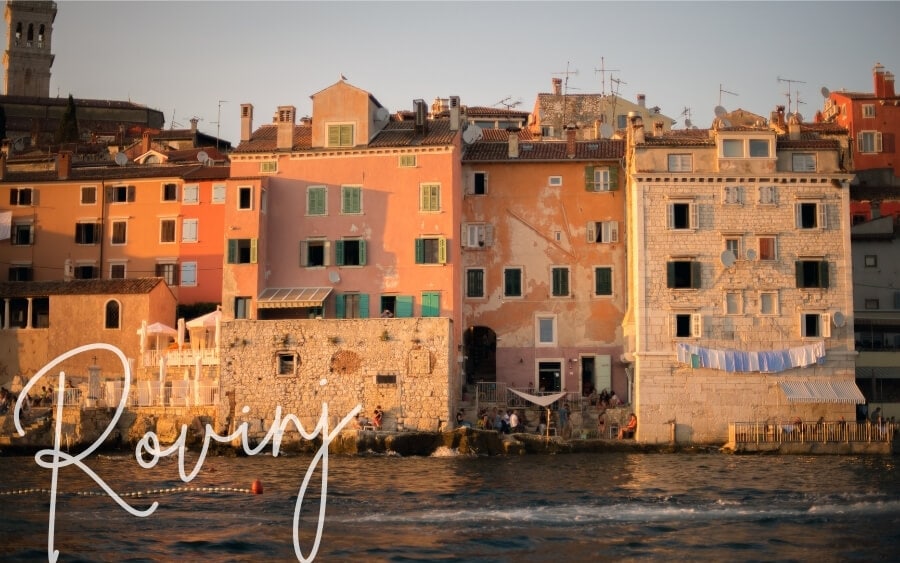
A breath of fresh air after the crowds on the Dalmatian Coast, northern Croatia’s Istrian Peninsula is a treasure trove of charming towns and villages. The port city of Rovinj is one of the larger cities and most popular destinations in Istria, luring tourists with its gorgeous cobbled streets, colourful buildings and lively fishing harbour.
Like many settlements along this stretch of the Adriatic, Rovinj was first established by the Venetians and Ilyrians then captured by Rome. Originally an island, it was only connected to the mainland in 1763.
The old part of the city – the rounded peninsula that was an island until the channel was filled in – is the prettiest part of Rovinj, with curved streets, Roman gates, piazzas, a surplus of Italian-style cafes, and the elegant Church of St. Euphemia right in the centre.
Swim at Plaza Balota or find a captain in the harbour to take you out for a day of island-hopping between the 19 islets just off the coast, a must-do when visiting Croatia.
Summer is peak season in Rovinj, so it’s nice to visit in shoulder season when the streets are quiet and the leathersmith and bootmaker workshops are the only stores open. Because of its position, Rovinj is an ideal base for exploring the rest of the Istrian coast.
- Get there: Fly into Pula Airport (40-minute drive) or take a bus from Zagreb, Piran in Slovenia or Trieste in Italy.
- Where to stay: Guest house Sotto I Volti is a charming stone apartment building accessed via one of the old town’s winding alleyways.
2. Zagreb
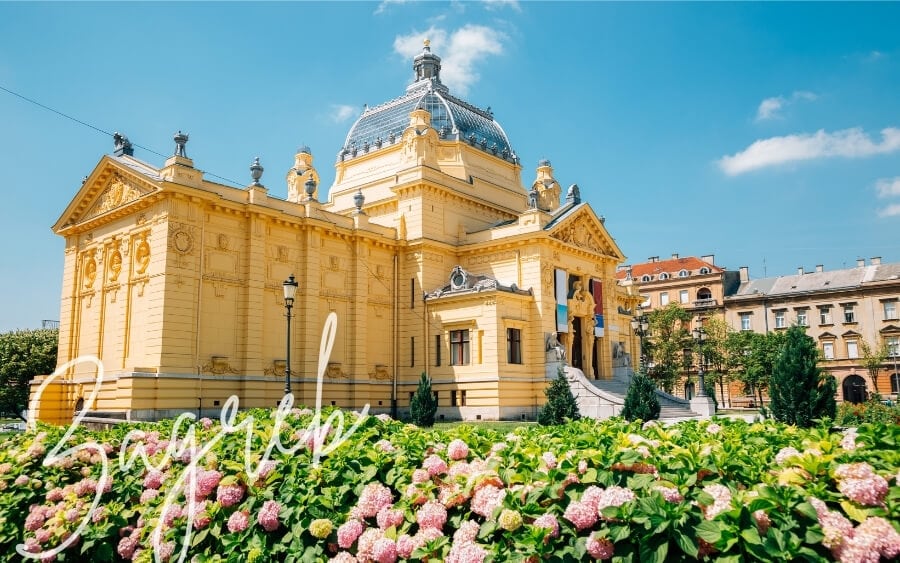
Croatia’s biggest city is often overlooked by travellers whose attention is drawn to the beautiful beaches and national parks in the south. But this is one of the most liveable capitals in the Balkans region and not one to miss if you’re a fan of beautiful architecture.
Zagreb is arranged in two parts: The Upper Town (Gradec) and the Lower Town. A third neighbourhood, New Zagreb, sits on the opposite side of the Sava River that flows through the city.
One of the most important landmarks in historic Zagreb is St. Mark’s Parish Church, with its vibrant tiled roof bearing twin coats of arms. The nearby St. Catherine’s is one of the finest Baroque churches in the country.
Admire the glass ceiling at Oktogon, the Secessionist-style tiled facade at Kallina house, rummage through vibrant produce at the Dolac Market, and wander through Lenuci Horseshoe (‘the Green Horseshoe’), a U-shaped configuration of city squares and parks in downtown.
Don’t miss the Mirogoj City Cemetery, a sprawling park filled with ornate tombstones and mausoleums on the city’s northern side. This is the final resting place for some of Zagreb’s most important residents and historical figures. It’s a sombre place, yet the cloisters, domes and ivy-covered walls make it one of the most beautiful places to visit in Zagreb.
- Get there: Fly into Zagreb International Airport or take a train from Ljubljana, Slovenia.
- Where to stay: Bed & Breakfast Sky City Center is just 100m from the Dolac Market and features stunning views over Zagreb’s main plaza.
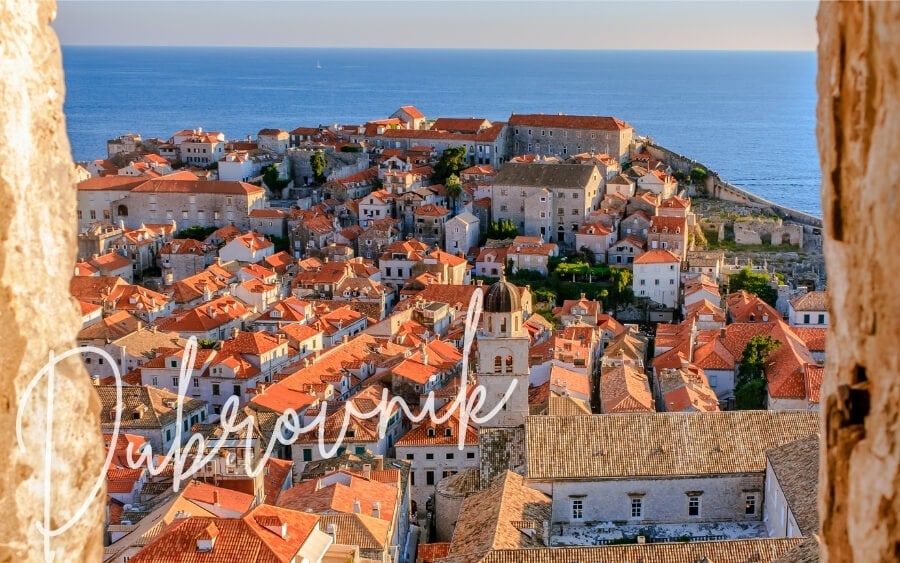
Known as the ‘Pearl of the Adriatic’, Dubrovnik is undoubtedly one of the best places to visit in Croatia. This small coastal city of around 50,000 people is nestled at the Southern tip of the country between Bosnia and Herzegovina and Montenegro.
Dubrovnik is a seafront city with a big personality, with stunning old town architecture, red-roofs and a fascinating history. Instantly recognisable thanks to its King’s Landing Game of Thrones fame, it’s become one of the most popular tourist destinations in the region.
The Old Town of Dubrovnik is a must-see. This fortified area holds plenty of historical sites within its boundaries, including the Pile Gate, Rector’s Palace and St. Ignatius Church.
Peruse the streets, enjoy a gelato and people watch to your heart’s content. Then head up to the fortress walls for a bird’s eye view of the Old Town. Be sure to wake up early in order to beat the crowds.
Also read: The best places to visit in Croatia in the off-season.
Afternoons are best for relaxing at Banji Beach, a beautiful white pebbled strip a 5-minute taxi ride east of Old Town. For sunset, take the cable car to the summit of Mount Srd for panoramic views of the city and beautiful coastline.
Dubrovnik is Croatia’s main port and the departure point for family-friendly boat trips and adult only cruises around the Adriatic and the Mediterranean.
- Get there: Fly into Dubrovnik Airport or take a bus from anywhere in Croatia.
- Where to stay: If you need a comfortable, compact base for exploring the old town, City Center Rooms boasts views of Old Dubrovnik’s rooftops from every window.
4. Pula
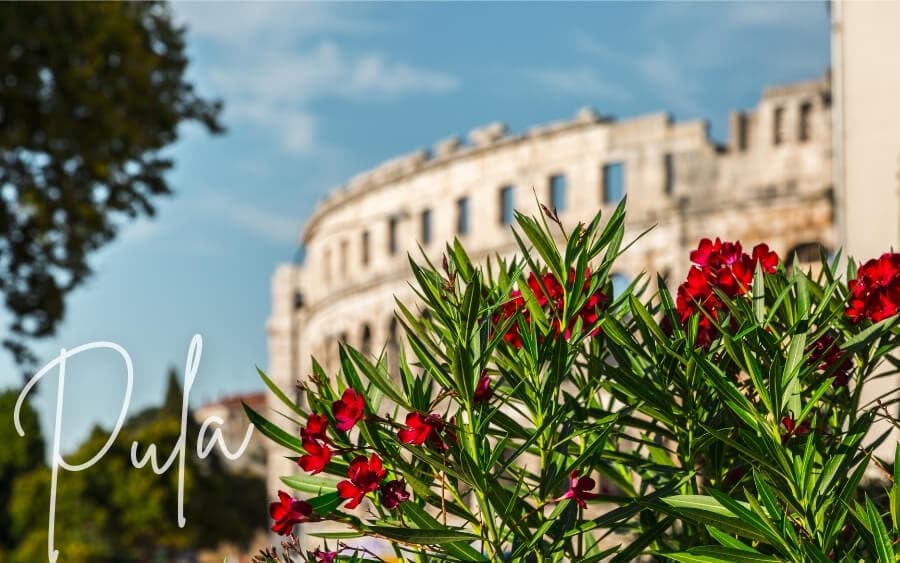
Another gem on the northern Adriatic, the Istrian city of Pula is known for one thing: The Pula Arena, one of the best-preserved Roman amphitheatres in Europe.
Built on a low hill, the arena comprises 72 limestone arches that tower 100 feet high. When it was completed around 27 BC, the theatre could accommodate up to 23,000 spectators.
Today, there is a small museum inside the grounds – but you don’t even need to step inside to be floored by the structure’s immense scale and exquisite engineering. All you need to do is take a walk around the perimeter. It’s especially nice at sunset, when beams of light peek through the stone arches.
The arena is still used today to host music performances and a film festival so if you’re lucky enough to be in town when there’s a show playing, make sure you snap up tickets.
For a bird’s eye view of the arena, head to the top of Fortress Kastel. Other points of interest in Pula are a second, smaller arena and the city’s Roman ruins: The Gate of Hercules, Arch of the Sergii, and the Temple of Augustus. These landmarks can all be found in the centre of the city, walking distance from the harbour.
- Get there: Fly into Pula International Airport or travel from Rovinj by bus.
- Where to stay: Apartment Irma is ideally located in the heart of the old town, close to the arena, the Olive Oil Museum, and Pula’s other main attractions.
5. Rijeka
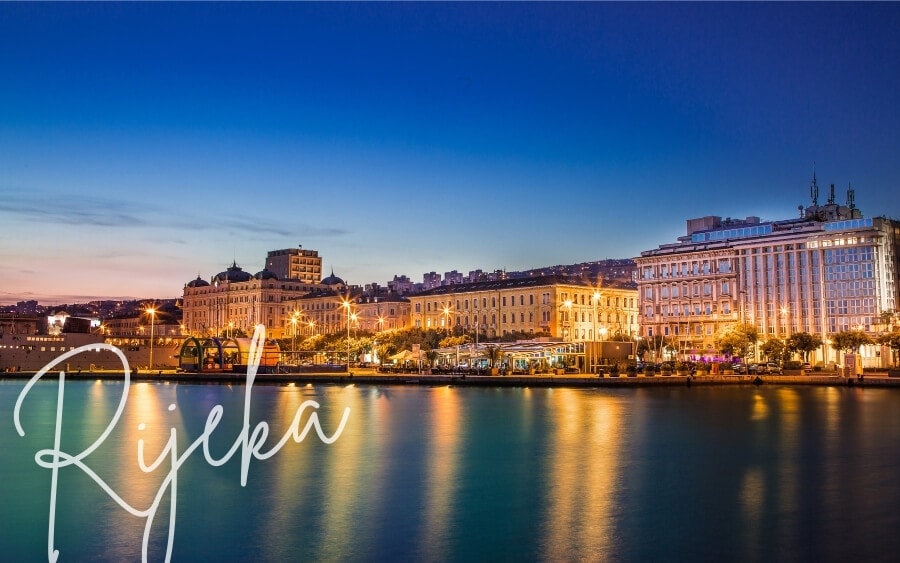
European Capital of Culture in 2020, Rijeka is the country’s third-largest city and a hub for literature and the arts. Its strategic location at the point where the Istrian Peninsula meets continental Croatia – and its deepwater port – have moulded Rijeka into a multicultural city.
Croat, Serb, Bosniak and Italian communities are all united by their dialect of Venetian language, Fiuman, which is still spoken by around 20,000 people.
Rijeka’s diversity has also shaped the city’s skyline, with a mix of Habsburg-era buildings, Venetian houses and colourful architecture typical of a Croatian fishing port. Life centres on the harbour, while Trsat Fortress behind the city is a must-visit for panoramic views.
As you wander the idyllic Old Town, keep an eye out for the rotunda-shaped Cathedral of St. Vitus, one of the city’s most distinctive landmarks.
Rijeka is the perfect destination for an offbeat city break while also offering easy access to hiking trails in Risnjak National Park. To the south of the city, a strip of coast around Sablicevo Beach offers rocky coves and white-sand beaches perfect for swimming.
- Get there: Fly into Rijeka International Airport or take a bus from anywhere in Croatia.
- Where to stay: Located on the western side of Rijeka and surrounded by cool, leafy forest, Apartmani Palmas Rijeka offers simple but comfortable apartments and suites.
6. Osijek
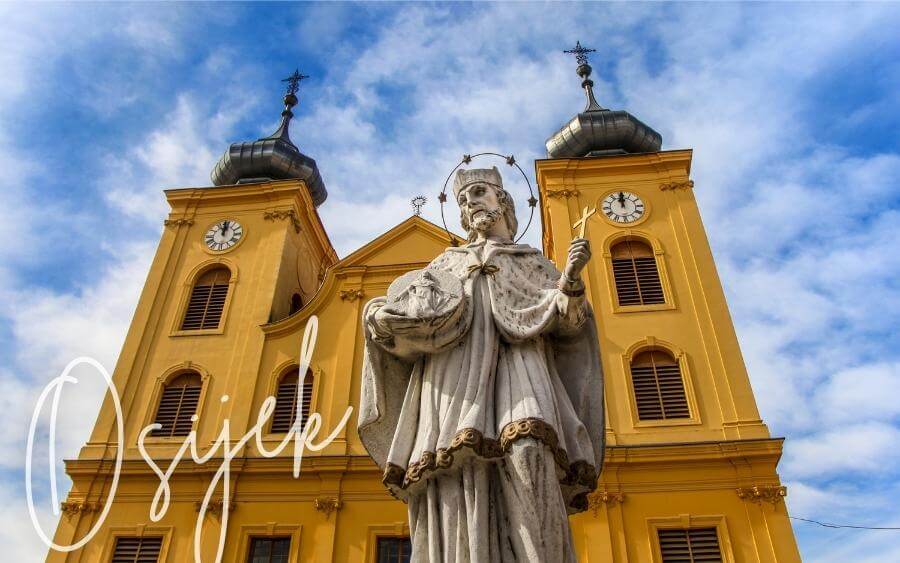
The capital of eastern Croatian’s overlooked region of Slavonia, Osijek is Croatia’s fourth-largest city and unofficial gastronomic capital. This is one destination to save your appetite for: Local Slavonian specialties including Kulen sausage and Riblji paprikaš fish both make heavy use of paprika – a nod to the city’s Habsburg heritage.
Osijek sits on the Drava river, close to the Danube that flows to Novi Sad and Northern Serbia, and is a very multicultural and historic city as a result. Despite all the different influences that have permeated the city over the centuries, Osijek has its own unique Slavonian cultural heritage that includes Croatia’s biggest Tambura festival (held annually in May) and summer fairs.
No matter the season, be sure to visit Osijek’s most beautiful landmarks: The Co-Cathedral of St. Peter and Paul, a stunning Neo-Gothic church built in 1898, and Ante Starčević Square with its historic architecture.
Osijek was the site of a major battle in 1991-1992 and you can see the scars of this quite clearly in the bullet pockmarks around town. Be sure to pay your respects at the War of Independence memorial and visit the iconic ‘Red Fiat’ (Crveni fićo), an unusual and moving tribute to an Osijek local who held off troops with his little red car.
- Get there: Take a train (5 hours) or bus (~4 hours) from Zagreb.
- Where to stay: The Bridge is a boutique apartment with free onsite parking.
7. Varazdin
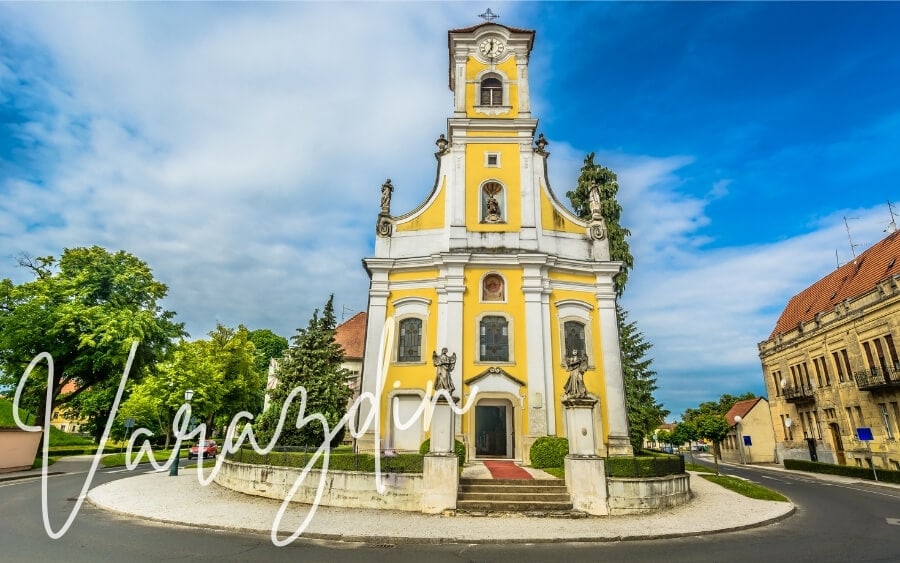
Located in northeastern Croatia close to the borders with Hungary and Slovenia, Varazdin (Varaždin) is home to one of the best-preserved old towns in continental Croatia. This might not be what first comes to mind when you think of Croatia – it’s a long way from the coast! – but Varadzin is beautiful in its own way.
The city is famed for its Baroque and Rococo buildings as well as its medieval fortress. Combined, these create a distinctive urban landscape that’s loaded with history. The Drava River runs through Varadzin, painting a backdrop to the 17th-century Sermage Palace and the Lisak Tower, part of the old city walls.
For a memorable experience, attend the changing-of-the-guard ceremony at Varadzin’s town hall, which takes place every Saturday. Don’t miss seeing the Croatian National Theatre (1873) designed by celebrated Viennese architects Herman Helmer and Ferdinand Fellner.
Varadzin is also known for its colourful festivals including the Baroque Music Festival, held annually since 1971 and Spancir, a street festival that takes place every September.
- Get there: Take a train (~4 hours) or bus (2 hours) from Zagreb.
- Where to stay: This Luxury apartment in the heart of Varazdin is spacious, beautifully decorated and well-appointed for a long stay.
8. Koprivnica
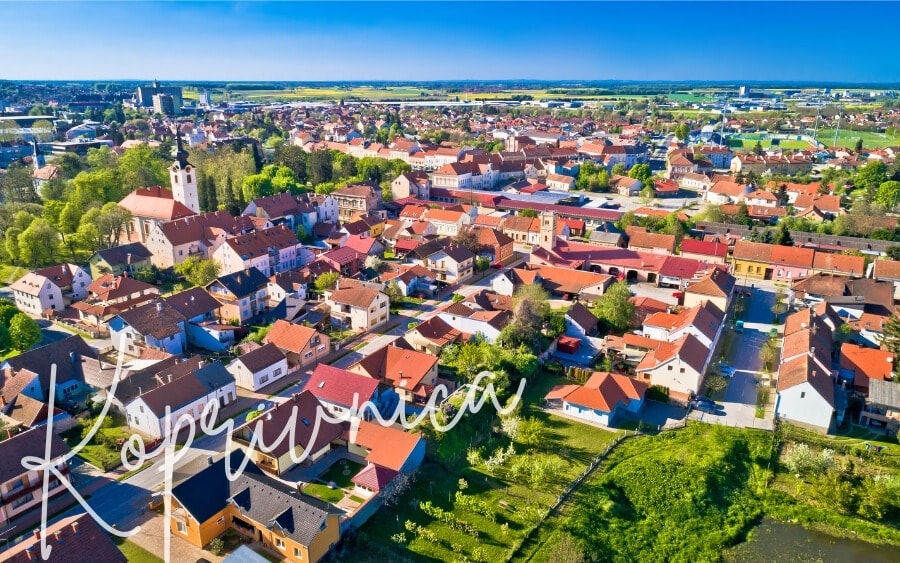
Koprivnica is the capital of the Koprivnica-Križevci county and another charming city in Croatia’s north, not far from Varadzin. Like its close neighbour, Koprivnica has sprawling green spaces, flat roads perfect for exploring by bicycle, and dozens of historical buildings.
For much of its history Koprivnica was a ‘border town’, marking the place where the influences of the Habsburg Monarchy and the Ottoman Empire met. The town visitors see today was mainly constructed in the 1860s, the same time the old fortifications were torn down and the new railway built.
The Koprivnica Synagogue (1875) is one of the city’s most beautiful buildings and a must-visit.
- Get there: Take a train from Zagreb (~2 hours) or drive from Varadzin (1 hour).
- Where to stay: Apartment Cecilia Koprivnica is a comfortable family-style guesthouse with a large garden and old-fashioned hospitality.
9. Sibenik
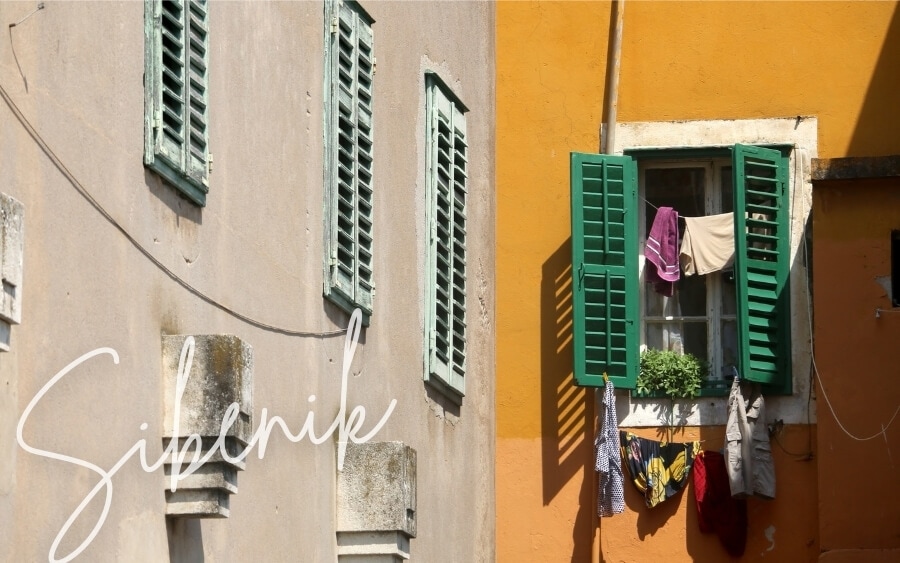
Conveniently located in central Dalmatia, the city of Sibenik (Šibenik) is the perfect destination for exploring the beaches and old towns along Croatia’s southern coast. Krka National Park – one of the country’s most pristine natural landscapes (coming up later on this list!) – is easily reached from Sibenik too.
Sibenik differs from other settlements in the area because it was originally founded by Croats. The city has had a tumultuous recent history, with many of its most prized pieces of historical architecture damaged during the Croatian War of Independence in the early 1990s.
The dome of the Sibenik Cathedral of St. James – a UNESCO World Heritage Site – was one such edifice wrecked in the bombings but has since been restored. Today, it’s Sibenik’s main landmark and visitors’ first port of call.
Sibenik has a quartet of fortresses: St Michael’s, St John’s, Barone Fortress and St Nicholas Fortress on the island of Ljaljevic (another UNESCO Site). Each one offers unique panoramas so to see Sibenik from every angle, it’s mandatory to visit all four.
Beautiful in its own right, the Kornati archipelago off Sibenik’s western coast is the densest in the Mediterranean, comprising 150 islands of various sizes and topographies.
- Get there: Fly into Split Airport (1 hour drive), take a train from Split or a bus from anywhere in Croatia.
- Guided day trip: Full-day tour from Split or Trogir, with Sibenik Old Town and a visit to Krka River and national park for the Skradinski Buk and Roski Slap waterfalls.
- Where to stay: Apartmani Rina offers simple, well-appointed rooms and breathtaking sea views from the breakfast terrace.
10. Zadar
By Raluca from Travel With A Spin
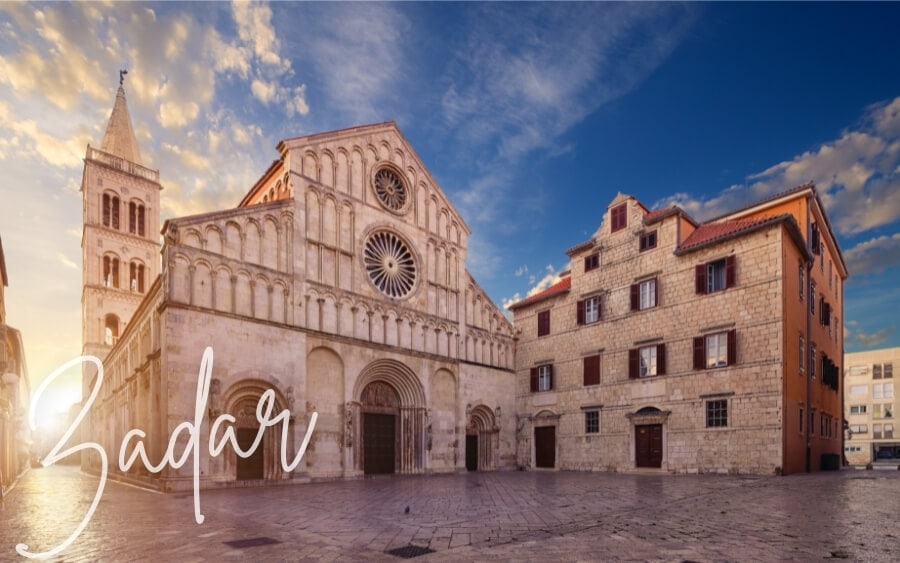
Zadar lies on the Dalmatian coast, on the way from Zagreb to Dubrovnik, a little under 300km from the capital. It’s lesser known than the other two Croatian cities, yet it’s a surprisingly nice place to visit.
First and foremost, Zadar has a gorgeous old town with Roman ruins, pretty squares, picturesque stone fountains and smooth cobblestone streets that sparkle in the sunlight just like an ice rink. Secondly, there’s a tower one can climb to see all this from above.
Other attractions to look out for in the city centre are the Roman Forum, Kalelarga, the largest street in the old town, People Square, the Square of the Five Fountains, the City Walls, and Queen Jelena Madije Park, the oldest public greenspace in Croatia.
But the heart of Zadar is in fact its seafront. Every evening, locals and tourists alike flock to the water’s edge to walk and chat. Besides the Mediterranean atmosphere, two works of public art draw everyone’s attention. One of them is a massive musical instrument powered by the sea waves, the ‘Sea Organ’. The second one is a huge panel powered by the light of the sun, called ‘Greeting to the Sun’.
There is no beach in the old town, but visitors can take a short 10-minute bus ride to Borik just outside the touristic area.
- Get there: Fly into Zadar International Airport or take a bus from anywhere in Croatia.
- Where to stay: Greta Residence (near the Church of St. Donatus) has spacious, stylish rooms just footsteps from all of Zadar’s biggest attractions.
11. Split
By Trijit from BudgetTravelBuff
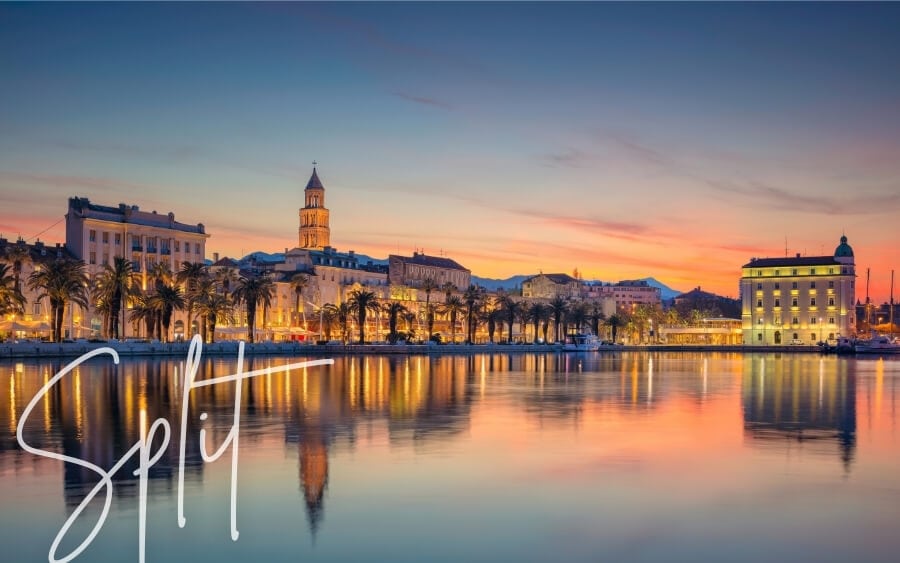
Also on the Dalmatian Coast, Split is a charming Mediterranean city just 4 hours’ drive from Dubrovnik. Split Airport is well connected to the rest of the world, while train, bus, and ferry services are available from other Croatian cities.
Split is historically significant; a place where the Romans left their mark with ancient walls, columns and medieval streets. Like Dubrovnik, filming for Game of Thrones took place here.
Split is safe and perfect for anyone who’s looking for a solo travel destination in Europe. Although Split is a small city, it has plenty of things to offer.
Start your day by visiting the Diocletian’s Palace, which was built in 305 AD as a retirement home for the Roman Emperor Diocletian. Now it is a UNESCO World Heritage Site and one of the most-visited places in the area.
Old Town of Split is a great place to enjoy a stroll through the narrow streets and cobblestoned lanes. People’s Square is located at the heart of the Old Town and filled with little cafes and restaurants. To get the best view of the city, you must climb the Bell Tower of St. Domnius Cathedral, which is considered the oldest Catholic cathedral in the world.
- Get there: Fly into Split International Airport or take a bus from anywhere in Croatia.
- Where to stay: There is no shortage of apartments and guesthouses in Split – for something well-positioned and well-priced, try Central Rooms Split.
Most beautiful towns in Croatia
Compact, walkable and oozing with old-world charm, these coastal and rural towns are the very best Croatia has to offer.
12. Motovun
By Coni from Experiencing the Globe
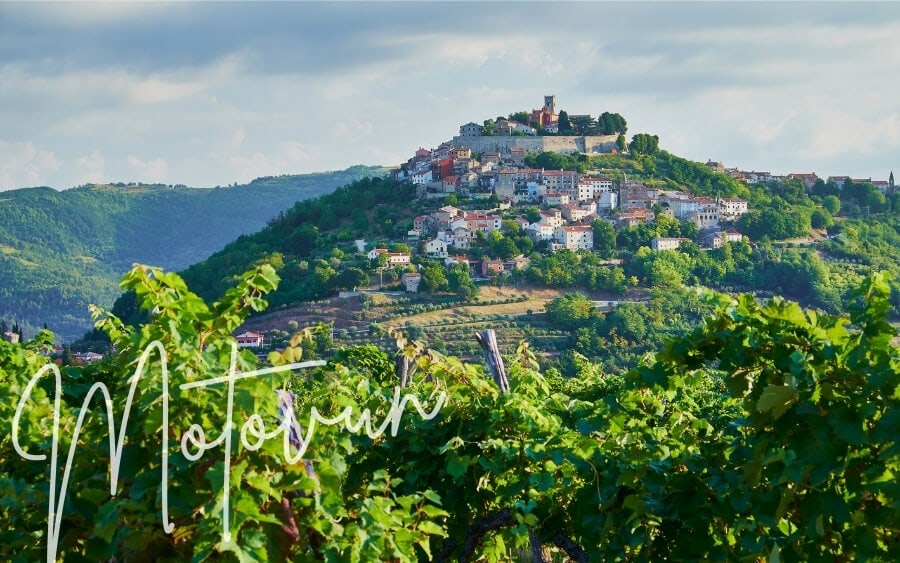
In the middle of the Istrian Peninsula overlooking the Mirna River Valley, medieval white and terracotta-roofed buildings spot a hill in the truest Tuscany style. It won’t come as a surprise that about half of the less than 1,000 inhabitants of Motovun still speak Italian, and call their town Montona d’Istria.
Strolling around, you’ll recognise the Venetian colonial architecture, with elements of Romanesque, Gothic and Renaissance styles. Don’t miss the 17th century Church of St. Stephen and its 13th century Bell Tower, nor the Municipal Palace in the central square.
But the absolute ‘must’ when visiting the town is the Motovun Forest, a specially protected area of 280 hectares (690 acres) known for its prized black and white truffles and the slopes where Teran and Malvazija grapes are grown for Istrian wine.
If you don’t want to get up close with the outdoors, this is the perfect destination to splurge, especially if you’re visiting Croatia in winter. Get a table in one of the restaurants overlooking the rolling Istrian countryside and sample the ingenious ways in which the chefs present the local truffles, perfectly paired with wine.
There are public buses going to Motovun from other Istrian towns, but the easiest way to get there and around is by driving.
- Get there: Fly into Pula International Airport (1 hour drive) or take a bus from Rijeka (75 minutes) or Rovinj (50 minutes).
- Where to stay: The panoramic town and valley views from the terrace at Villa Borgo B&B in the heart of Motovun old town cannot be beat. If the season is right, truffle hunting expeditions can be arranged at the front desk!
13. Jelsa
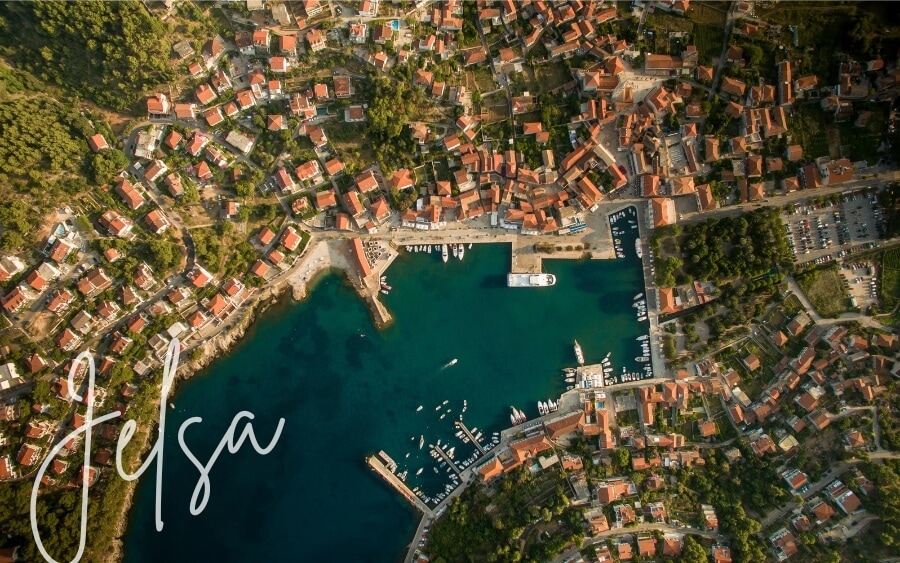
While the entire Hvar Island is a paradise in Croatia (find more things to do on Hvar later on this list), one of the highlights is undoubtedly the small town of Jelsa. Surrounded by pine forests and greenery, Jelsa sits in the centre of the island, east of Hvar Stari Grad, and has a beautiful bay and long sliver of coastline all to itself.
Today the town has fewer than 4,000 residents, but Jelsa has a long history of habitation dating back to at least 1331. The Gradina peninsula is a hotbed of culture and archaeological ruins – here you can view the remnants of the old city wall that once encircled Jelsa’s houses and churches.
Jelsa’s location on a sloping ridge means there are dozens of observation points in and around town where you can hike up for stunning water views. The fortress of Tor reveals views all the way to Brac and the Makarska coast, while the Ilyrian Grad Fortress teeters above an ancient trade road.
Other points of interest in Jelsa include the 14th century Church of St. Mary, with its bell tower and unique statue of the Madonna carved from wood. Croatian Renaissance Square, the town’s main square, has an ancient water spring and is walking distance from the lush Perivoj public gardens, with its oleander and bay laurel trees, and its curious statues.
- Get there: Take a taxi or bus from the Hvar ferry port (10-15 minutes).
14. Hum
By Jackie from Jou Jou Travels
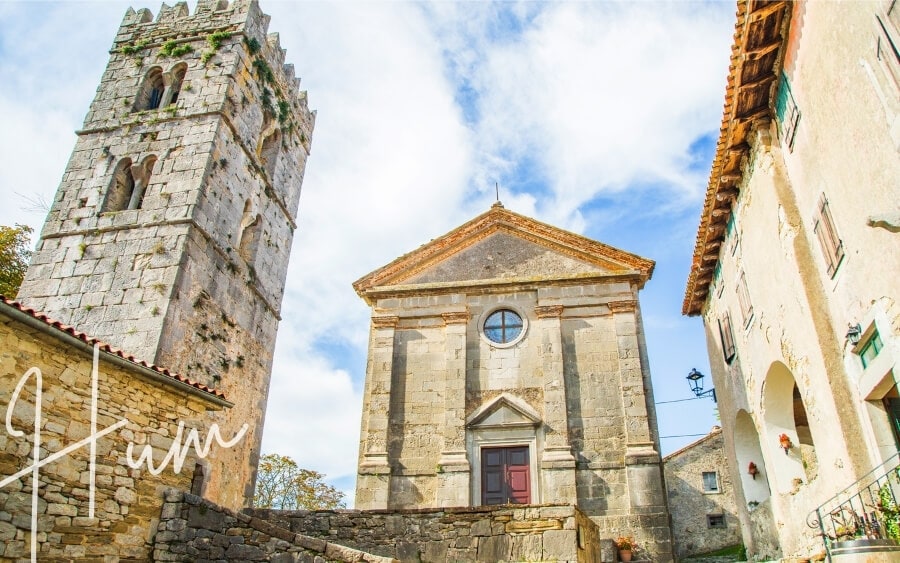
Hum is situated in the central part of Istria, an hour from Rovinj and adjacent to Zagreb. With a population of only 30 people, Hum is famous for being the smallest town in the world – as recognised by the Guinness World Records.
According to legend, Hum was founded by giants who had only a few stones left to build a city – thus they created a miniature town with what was left.
If you’re planning a road trip through Istria, Hum should be a fixture of your itinerary. You can combine a visit to the town with other towns and cities nearby such as Rovinj, Pula, Motovun, and Groznjan. You only need an hour or two to see everything Hum has to offer.
You don’t need an agenda or a plan: Just walk and admire the architecture and surrounding nature. The town is very simple with a cemetery, twin churches and just one restaurant called Humska Konoba, where you can try Istrian food.
Thanks to the Medieval vibes, visiting Hum feels like travelling back in time. Don’t miss it – even if it’s just to say you’ve visited the smallest town in the world.
- Get there: Fly into Pula International Airport (1 hour drive) or take a bus from Rijeka (1 hour).
- Where to stay: With its rustic stone facade and blue shutters, House Vera is a typical Istrian villa fitted out with all the mod-cons you need for a comfortable stay.
15. Groznjan
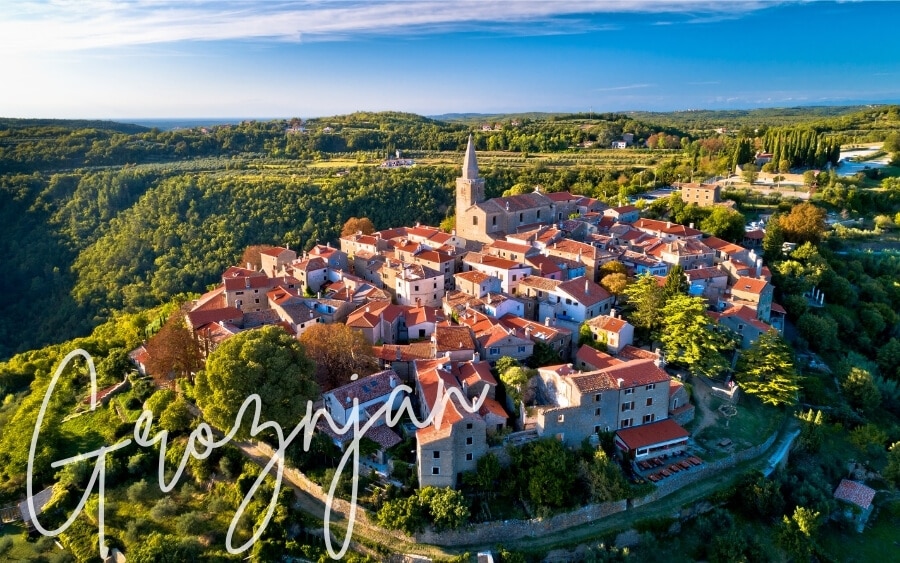
Groznjan (Grožnjan) is known as Grisignana in Italian and like Motovun, has a rich history and a deep connection to Italy. Whether viewed from afar or up-close when walking the cobbled streets, Groznjan’s cloisters, paved alleys and stone piazzas make this one of the most picturesque towns in Istria.
Despite its diminutive size (fewer than 1,000 people call Groznjan home), the town has two dozen art galleries and hosts a popular jazz festival every July – hence why the town has earned the nickname ‘The City of Artists’.
From its perch on a flat-topped hill, Groznjan overlooks vineyards and olive groves. The soil in this area is mineral-rich and perfect for growing both grapes and organic produce, which has in turn made this area wildly popular for agritourism.
It’s also one of the most desirable destinations in Croatia for foodies, with taverns cooking up traditional Istrian fare using the glut of fresh produce available at their fingertips. Enotourists will be pleased to learn that some of Europe’s most underrated wines are made in this area.
- Get there: Fly into Pula International Airport (1 hour drive) or take a bus from Rovinj (1 hour).
- Where to stay: App Lidia is a gorgeous self-contained holiday house set in a traditional stone Istrian home, with exposed roof beams and a farm-style kitchen.
16. Primosten
By Martina from PlacesofJuma
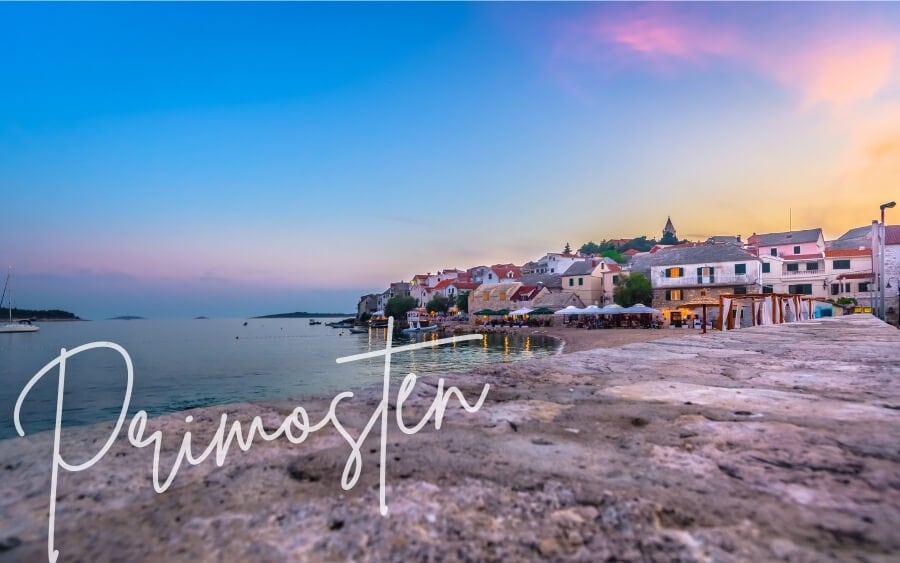
Primosten (Primošten) is one of the most charming coastal towns in Croatia and a destination that should not be overlooked. This former fishing village is located in Dalmatia, between the famous cities of Split and Sibenik, and is ideal for an excursion or as a place to stop between the two.
The picturesque old town, which is located on a peninsula, is a real highlight and enchants with its narrow streets and beautiful old houses. While walking around, you will discover something beautiful at every corner. The restaurants in the old town are fabulous, too.
Not only is the town architecture beautiful, the magnificent beaches on the outskirts of Primosten are breathtaking. Seas off the town’s 10km of coastline are turquoise blue and crystal clear, and thus perfect for swimming and snorkelling.
One of the most important attractions in Primosten is the statue of Our Lady of Loretto. Located on a hill above town, the lookout here offers the most exquisite views.
- Get there: Fly into Split International Airport (40-minute drive) or take a bus from Sibenik (40 minutes).
- Guided day trip: Krka National Park tour from Split, with a stop in Primosten to wander the old town.
- Where to stay: Pansion Kamenar is in the centre of the Old Town features a huge rooftop terrace for sunset views.
17. Klis
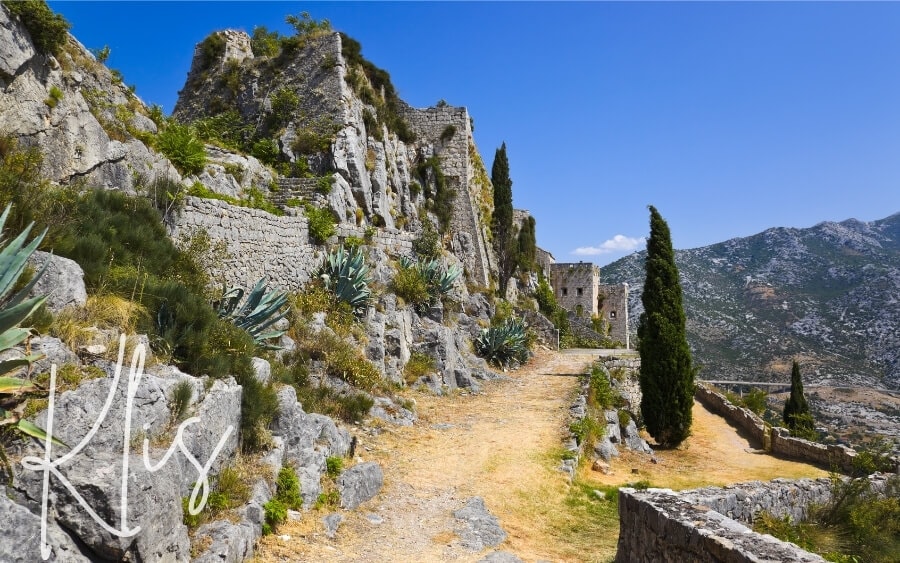
Located in the hills above Split, Klis is known for its mountain fortress. The town surrounding the stone walls bears the same name and the same views of the coast. A quick bus ride from the city, Klis feels a world away from popular Split and is the perfect place to beat the crowds.
Overlooked by the dramatic peaks of the Klis mountain pass, the small town stretches out at the foot of the castle, it’s stone walls providing a picturesque backdrop to the collection of red-roofed houses.
Within the fortress complex, you’ll find one of only three preserved Ottoman-era mosques in Croatia. Down one of the streets in the town, a rare Turkish water fountain is another hint at this area’s history.
- Get there: Take a bus or drive from Split (30 minutes) or Sibenik (50 minutes).
- Guided day trip: Tour the Roman City of Salona, Klis Fortress and Trogir from Split.
- Where to stay: Holiday House Dora is a spacious two-bedroom property with a private pool and sea views.
18. Trogir
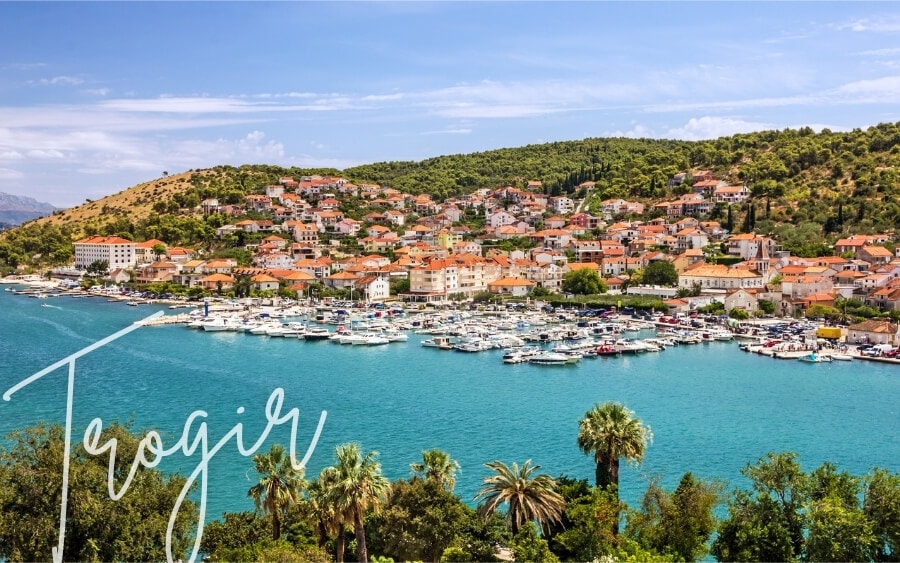
If you’re arriving in Croatia at Split Airport, instead of heading east towards the city, make a detour west to the town of Trogir. The small island that holds Trogir Old Town – a sea of orange-topped houses that melt into the Adriatic beyond – is everything you imagine a beautiful Croatian town to look like, and then some.
On street level, Ciovo island blends Renaissance, Romanesque and Baroque architecture. UNESCO recognised the significance of Trogir’s Venetian buildings in 1997 when it named the entire historic centre a World Heritage Site.
Make a beeline to the Renaissance Chapel of St. John and climb the bell tower for a sweeping view before tracing your way along the preserved portions of the city wall. At sunset, head to the Tower Kamerlengo Trogir on the western end of the island for more spectacular views.
In between, visit some of the 10 churches on the island and wander the streets at will to discover what makes Trogir the best-preserved Romanesque-Gothic complex in all of Central Europe.
- Get there: Take a bus or drive from Sibenik (50 minutes) or Split (30 minutes).
- Where to stay: For old-world elegance in the heart of the Old Town, Dimora Picco Bello has delux doubles and suites with elegant furnishings.
19. Cavtat
By Helen from Helen on Her Holidays
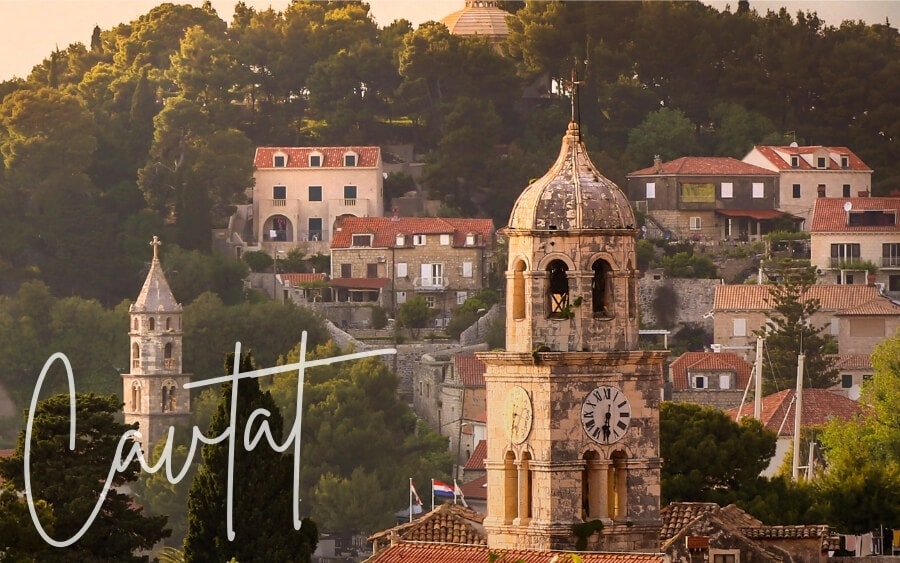
Cavtat is a small seaside town at the very tip of Croatia’s Dalmatia region. Mid-way between Dubrovnik to the north and the border with Montenegro to the south, it’s a great place to stay when travelling around this part of Croatia.
Cavtat is set in a sheltered, horseshoe-shaped bay, backed by mountains. The edges of the bay are covered in dense pine forests, with walking trails and cosy beach bars nestled on the shoreline. The main promenade is lined with palm trees and is a popular place for visiting superyachts to moor. Despite this, the town itself feels remarkably unpretentious.
There are two particularly memorable experiences which you must not miss on a trip to Cavtat. The first is a trip to Dubrovnik by boat. Departing from Cavtat’s lovely bay, you’ll travel past some of the most gorgeous parts of the Croatian coast before arriving at Dubrovnik’s historic port.
The second is seeing the sunset. In summer, the sun sets directly between the two peninsulas which form the bay, with Dubrovnik in the distance.
After dark, you can see the lights of Old Town Dubrovnik twinkling as you sip your cocktail in one of Cavtat’s promenade bars. It’s a magical experience.
- Get there: Take a bus or drive from Dubrovnik (30 minutes).
- Where to stay: Apartments Ana Old Town is set in a charming stone house close on the peninsula, walking distance from the centre of Cavtat.
20. Makarska
By Martha from May Cause Wanderlust
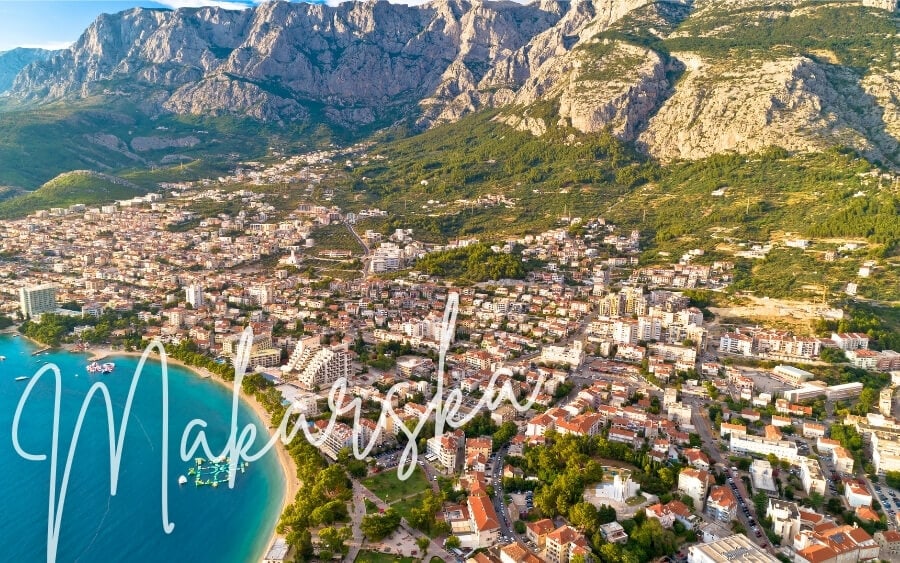
Makarska is a busy harbour town on the Makarska Riviera, set against the imposing Biokovo Mountain. Visitors can explore the pretty town, its harbour, the Franciscan monastery and a botanical garden. If you prefer something more active, you can hike in the Biokovo Nature Park or even go parasailing.
There’s a lovely pebble beach, which is lined with fir trees and blessed with gorgeous sunsets. There are plenty of good restaurants to choose from in the town, too. You can use Makarska as a base from which to explore the wider area: there is a ferry connection to nearby Brac island, which has the famous Zlatni Rat Beach, and it’s possible to join organised tours of the small Croatian islands and coves.
Makarska is approximately 90km south of Split and 150km north of Dubrovnik, thus it could be a great stopover as part of your Croatian road trip. There are also bus and ferry connections from the two cities.
However, the best way to get there is to sail! Sailing the Dalmatian Coast is really special, and Makarska often features as an overnight stop on organised sailing holidays in the area.
- Get there: Take a bus or drive from Split (75 minutes) or Dubrovnik (2.5 hours).
- Where to stay: Hotel Biokovo is a 3-minute walk from downtown Makarska and the central beaches.
21. Novalja
By Phil from JOURNICATION Travel Blog
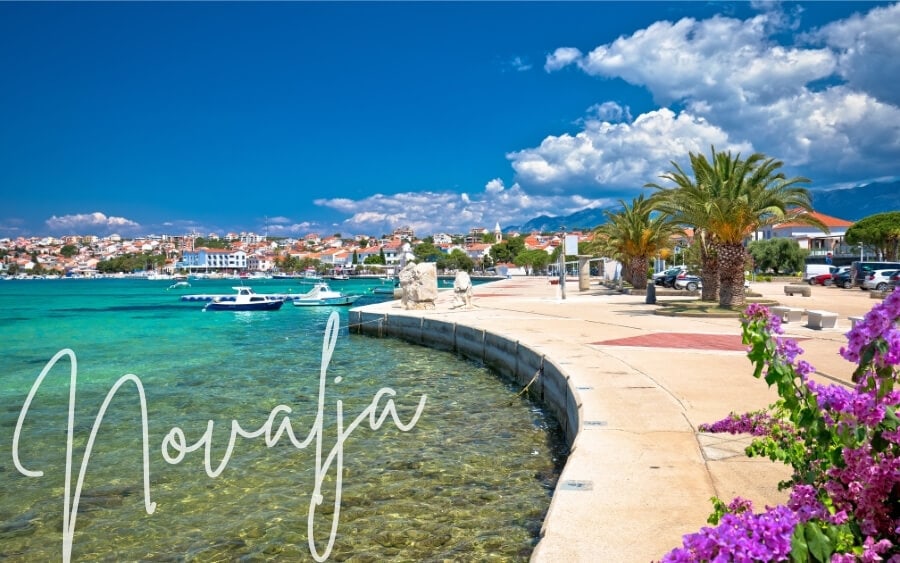
Novalja on the island of Pag is certainly one of the lesser-known destinations in Croatia. Pag is located between tourist heavyweights Rijeka and Zadar. No matter where you are on the island, you can always see the sea!
The history of Novalja and its surrounding area goes back more than 2,000 years. The Romans used Caska on Pag as an important port on the Adriatic Sea. Today, the remains of their settlements are under water. Everywhere you go you can find great beaches and all kinds of water activities.
The beaches of Rucica in Metajna, Veli Zal in Zubovici and Strasko south of Novalja are all popular choices.
Novalja is also the starting point and accommodation hub for the party stronghold of Zrce, a pebble beach roughly 3km from the city centre. Iconic clubs such as Euphoria, Aquarius and Papaya are located directly on the beach and have hosted many famous artists over the years, including Swedish House Mafia, Tiesto and Robin Schulz.
Every day, after sunbathing and relaxing by the sea, the ‘After Beach Party’ takes place at Aquarius – comparable to Après Ski during winter vacations in the Alps.
So if you feel like a beach break combined with unforgettable parties to complement a visit to the nearby walled city of Dubrovnik, Novalja and Zrce Beach are a great addition to any Croatia itinerary.
- Get there: Take a bus or drive from Zadar (1.5 hours) or Rijeka (3 hours including a short ferry ride).
- Where to stay: The 4-star Boutique Hotel Boškinac has beautiful suites, a pool and wine cellar.
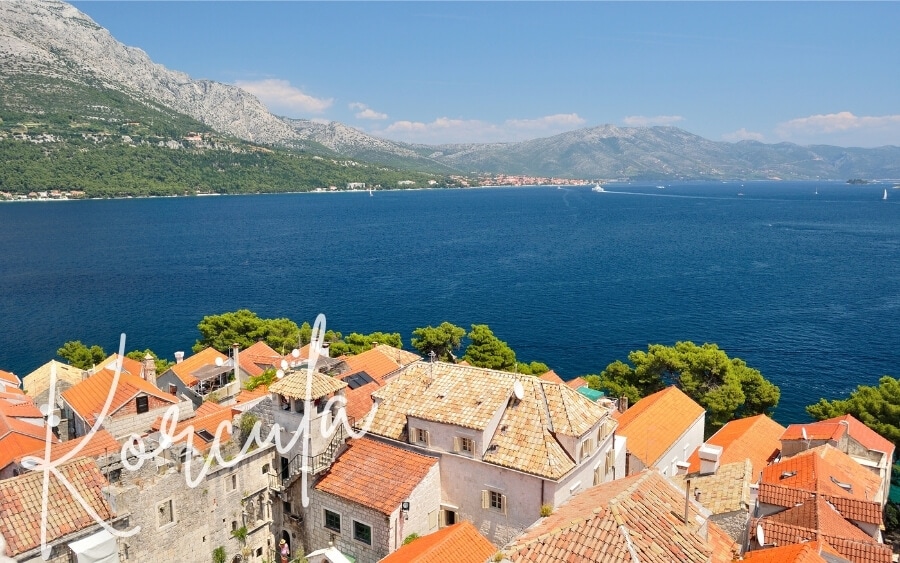
Popular for its wine scene and exquisite beaches, Korcula (Korčula) is a great choice for anyone seeking a peaceful break. The best way to spend your time in Korcula is to cycle around the vineyards, tasting local wines as you go.
Exploring historical Korcula town is another must. Don’t miss the Gothic-style St. Mark’s Cathedral or the Korcula Town Museum. If you’re visiting during the peak summer season, make time to see the Moreska sword dance, a traditional performance that conveys the story of two kings engaged in a sword fight.
As well as wine, Korcula has a couple of small breweries and plenty of pubs that serve amazing local beers. The seafood is a must-try, with Korcula serving up some of the freshest fish on the coast.
Korcula is only accessible by ferry from Split or Orebic. Times are fixed, so plan your trip accordingly.
- Get there: Take a ferry from Split (2.5 hours) or Orebic (20 minutes).
- Guided day trip: Full-day tour to Korcula from Dubrovnik, including a visit to a local winery.
- Where to stay: Located in Lumbarda on the eastern end of Korcula, Guesthouse Cipre is a traditional family style guesthouse close to white-sand beaches at Prvi Zal, Bilin Zal and Vela Przina.
Beautiful Croatian beaches & islands
Croatia is a nation known for its white-sand beaches and dreamy islands. Here is a short-list of the very best places for sun, sailing and surf.
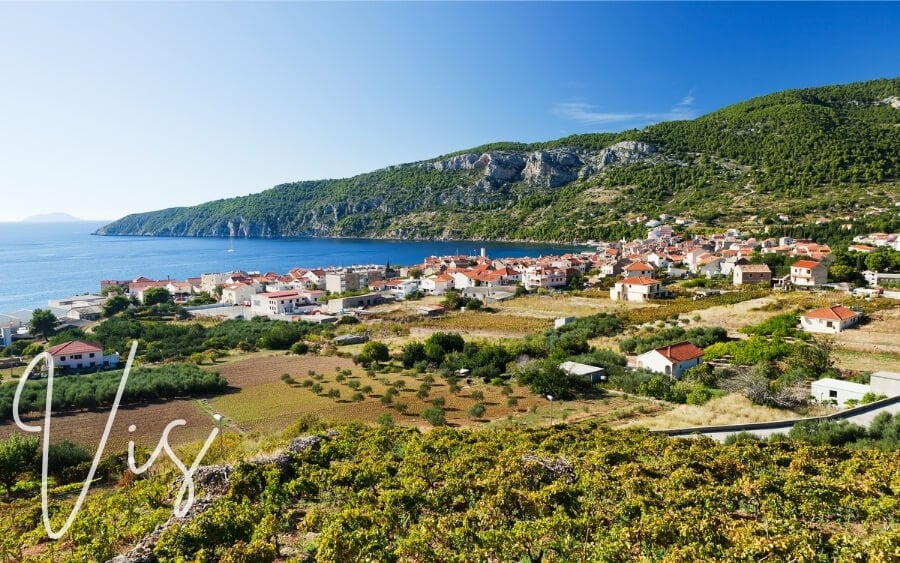
Hop on the ferry in Split and within 2 hours, you’ll find yourself on one of the most idyllic islands in all of Croatia, Vis. This island still remains an untouched hidden treasure, as most tourists choose to visit popular Hvar instead.
Vis is the perfect place to rent a scooter and breathe in that fresh Mediterranean air. Along the twisting roads, explore the many viewpoints, vineyards and specialty restaurants that prepare fresh seafood.
There is a wide range of beaches, most of them un-commercialised and undeveloped. It’s not unusual to see a lone nude sunbather enjoying the empty coastline! There are a few small boat trips you can take to circumnavigate the island and take in the highlights.
The charming village of Komiza is an ideal place to stay. Here, you’ll find plenty of cobblestone streets that lead to intimate oceanside restaurants. Across the tiny fishing port, explore the adjacent island of Bisevo. This tiny islet boasts its own grottoes (including a Blue Cave), and is a quick and easy boat ride away.
Vis is the best island in Croatia to slow down, relax, sip a glass of wine, and savour the simple moments.
- Get there: Take a catamaran from Hvar town (50 minutes) or a ferry from Split (1.5-2.5 hours).
- Guided day trip: Private tour of the 5 Islands by speedboat (including Vis and Hvar) with snorkelling and a visit to the Blue Cave (departs from Split or Trogir).
- Where to stay: Guesthouse Kod Tri Palme is 200m back from Vagan Beach, walking distance from both the harbour and Vis’s cafes and restaurants.
24. Hvar Island
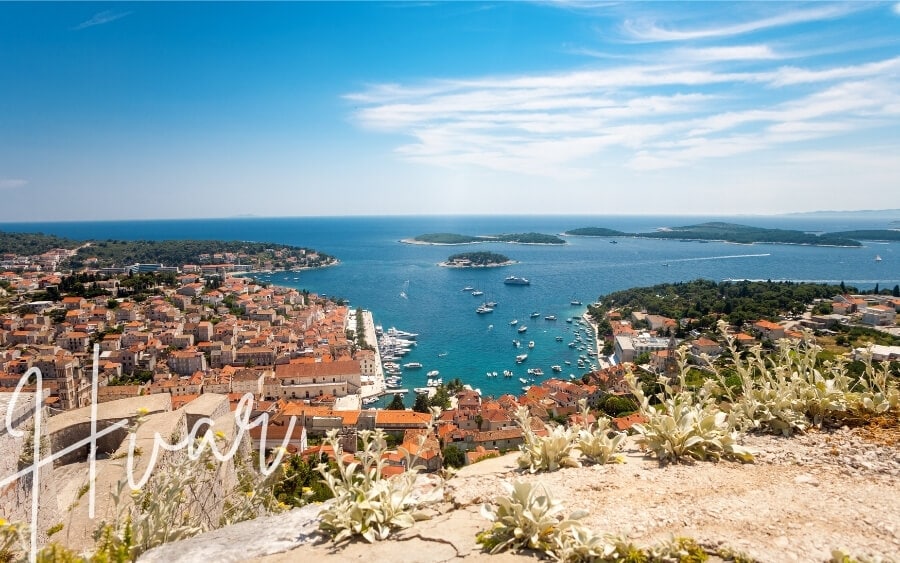
Consistently listed among the world’s top 10 islands by Conde Nast Traveller, Hvar is a green island with a red-roofed old town typical of the Croatian coast wrapped in a blanket of sparkling coastline. From beaches and coves to the streets of Stari Grad, it really doesn’t get any more idyllic than this.
The interior of Hvar is perhaps the island’s biggest treasure: Vineyards, fruit orchards, groves of olive trees and even lavender fields dominate the centre. Follow the long road from east to west to explore the landscape and visit the small towns and villages dotted along the narrow island.
In Stari Grad, learn about Hvar’s history at the small museums before heading south to Hvar Old Town and summiting either the Spanish Fortress or more-remote Napoleon Fortress for sunset.
- Get there: Take a ferry from Split (60 minutes) or Brac island (30-60 minutes).
- Guided day trip: Full-day sailing tour of Hvar and the Paklinski Islands, with lunch at a local restaurant and sunset cocktails on the beach.
- Where to stay: For something different, Plage Cachée offers luxury glamping tents in Vrboska on Hvar’s northern shore, close to Zecevo Beach.
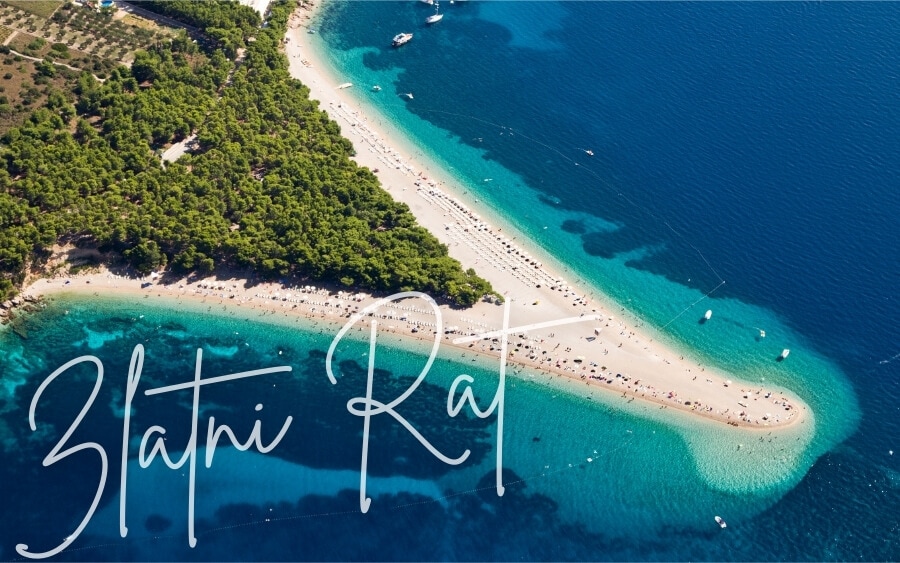
Named one of the world’s best beaches, Zlatni Rat is by far the most popular stretch of shore in Croatia. Zlatni Rat means ‘Golden Horn’ in Croatian, a name that comes from its distinctive V-shape. This beautiful beach is so popular, it has become a national tourism symbol for Croatia.
The beach is located on Brac island, roughly 3km from the town of Bol. One can easily see the shape of the beach from the road that descends to the coast. If you prefer to travel by water, tourist boats depart for the beach regularly from Bol port.
The beach itself comprises fine white pebbles and is encircled by a Mediterranean pine grove that slowly transitions into the Adriatic. Strong currents from the Hvar channel make Zlatni Rat perfect for windsurfing, wakeboarding, jet skiing and sea kayaking, and there are many cafes, resorts and restaurants around the beach to choose from.
Zlatni Rat is known as ‘the beach that changes shape’ – because of the strong winds and currents, the V shape is constantly shifting, tilting mostly towards the east.
- Get there: Take a ferry from Makarska (1 hour).
- Guided day trip: Off-road tour of Brac Island with a local guide, with wine tasting, views from Vidova Gora and a chance to swim on Zlatni Rat Beach.
- Where to stay: Set on a winery in Bol, 20 minutes by foot from Zlatni Rat, Holiday Home Vineyard House is a secluded property with a private pool and sea views.
26. Elaphiti Islands
By Baia from Red Fedora Diary

The Elaphiti Islands is a small archipelago incorporating several islands northwest of Dubrovnik. Covering approximately 30 square-kilometres of land area, the rugged islands only have 850 inhabitants. Exploring the Elaphites is a perfect day trip from Dubrovnik if you want to get away from the crowds or do a bit of island hopping.
Incredibly, the exact number of Islands is unknown. However, as stated by a relatively recent analysis, the archipelago has 13 major islands as well as many smaller uninhabited islands.
Of these, the main ones to explore are Lopud, Sipan, and Kolocep. These islands are permanently inhabited and the easiest to get to from Dubrovnik’s Gruz port, with daily ferries available.
The archipelago is a go-to destination for locals during the high season to relax on the relatively quiet beaches, while tourists enjoy historical sights, restaurants and sunbathing.
Kolocep used to be a significant shipbuilding area during the Republic of Ragusa and is home to seven pre-Romanesque churches dating from the 9th-11th centuries. Lopud is the second-largest island, featuring some of the best sandy beaches in the archipelago along with chapels, churches and monasteries.
The largest island, Sipan, has two hamlets: Sudurad and Sipanska Luka. Like the other islands, attractions here include noble houses, churches and monasteries, and many dining venues.
- Get there: Take a ferry from Dubrovnik (1 hour).
- Guided day trip: Elaphiti Islands day cruise from Dubrovnik, with snorkelling and lunch included.
- Where to stay: Hotel Bozica in Sudurad on Sipan is one of the finest hotels in the islands, with sea views from the terraces and pool deck, and an onsite restaurant that specialises in meals made from local, organic produce.
27. Mlijet
By Milijana of World Travel Connector

If you want to see what true paradise on earth looks like, you need to visit Mljet island near Dubrovnik. The greenest island in the Adriatic Sea, it’s home to the magnificent Mljet National Park, with gorgeous Aleppo pine and oak forests, stunning vineyards, olive groves, two inland saltwater lakes with charming islets, numerous beaches and hundreds of small coves.
The name of the island comes from the ancient Greek ‘Melita’, meaning honey. Legend says that Mljet is the mysterious Ogygia where Odysseus spent several years on his journeys. Today, visitors can swim and dive in the magical Odysseus Cave, famous for its spectacular light effects.
Bike, hike, and explore the island’s trails, swim and kayak in the Great and the Little Lake, visit a Benedictine monastery on the islet of Santa Maria, visit the ancient Roman palace on the island, dive and explore the marine life and an amphorae site, taste homemade local dishes prepared with fresh ingredients…
Just be careful because you might be so overcome by the beauty of Mljet, you’ll be tempted to stay on the island for several years just like Odysseus!
- Get there: Take a ferry from Dubrovnik (1.5 hours).
- Where to stay: Apartments Slavica overlooks the harbour at Pomena and is convenient to the island’s restaurants and beaches as well as the national park.
28. The Blue Lagoon (Krknjasi Bay)
By Ella from Many More Maps
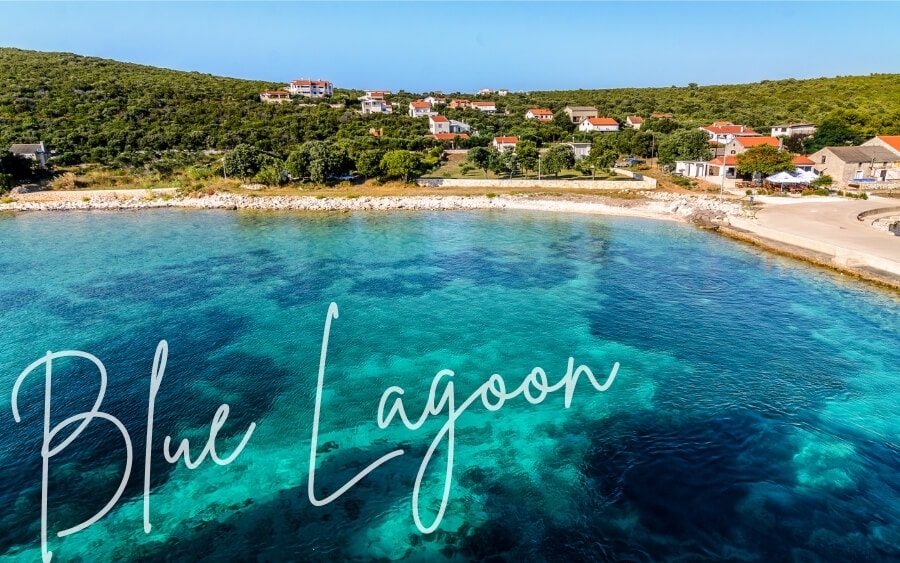
Visiting the Blue Lagoon (AKA Krknjasi Bay) should be on every visitor’s Croatia bucket list. Nestled between the Dalmatian islands of Veliki and Krknjasi, the Blue Lagoon is an area of calm, clear and unbelievably blue water that travellers just can’t get enough of. When island hopping in Croatia, this is an essential stop.
Visitors come to the Blue Lagoon to swim and snorkel in the refreshing water, snap photos, and sunbathe on nearby Veli Drvenik island, which you can swim up to from your boat.
Since it’s so remote, getting to the Blue Lagoon independently can be expensive and a lot of hassle, thus the most popular (and easiest) way to visit is on a 3 or 5 island boat tour from Split. Another option is to hire your own boat.
Tours usually stop off at the Blue Lagoon for between 60-90 minutes, which is plenty of time to explore the area and soak up its beauty.
- Get there: Join a day tour from Split or Trogir.

Cres, Croatia’s second-largest island, is not located in Dalmatia but rather off the country’s northern Adriatic Coast in Istria. This island has been inhabited since Paleolithic times and has witnessed countless historical events, as evidenced in the island’s diverse architecture.
A central road connects several small villages and towns, with Veli Losinj and Mali Losinj at the southern end of the island being the most popular among tourists.
Cres is one of three last remaining habitats for griffon vultures in Croatia, making this a prime spot of bird-watching. Their nesting grounds are found on the northern end of the island around the village of Beli. Lake Vransko, one of the largest freshwater lakes in the country, is another popular spot for outdoor enthusiasts.
For swimming, the pebbled beach at Martinscica and the hidden beach at Mali Bok are both great choices. For panoramic views of the Tramontana Woods and Niksa and Krizic peaks, follow the hiking trails through the island’s interior.
- Get there: Take a ferry from Rijeka (1.5 hours).
- Where to stay: Guesthouse Maver offers self-contained studio apartments close to Grabar Beach.
Beautiful national parks & waterfalls in Croatia
Croatia’s green heart is every bit as beautiful as its coastline.
30. Paklenica National Park
By Katy from A Rambling Unicorn

Fall in love with Croatia’s stunning Velebit mountains by visiting Paklenica National Park. Located an hour’s drive from Zadar, Paklenica is a gorgeous landscape famous for dramatic canyons and black pine forests. The park is beloved by climbers who can often be seen ascending the various rock formations.
One of the best ways to explore Paklenica’s towering limestone cliffs is on foot. Paklenica National Park hiking trails meander through the Velebit mountains and showcase the region’s rugged beauty. From easy tourist routes to strenuous mountain treks, there’s something for everyone.
The Velebit Hiking Trail (Velebitski Planinarski Put) is one of the park’s most popular routes and leads to several idyllic mountain huts. Visitors can also hike to Manita Pec cave and explore the cavern as part of a guided tour.
Located just outside the entrance, the village of Starigrad-Paklenica makes a great jumping off point for exploring. The town offers restaurants and lodging as well as an outdoor store with basic climbing and hiking supplies.
While arriving by car is the easiest transportation option, visitors without a vehicle can take the bus to Starigad-Paklenica from Zadar and walk to the entrance on foot.
- Get there: Take a bus or drive from Zadar (60 minutes).
- Guided day trip: Full-day tour from Novalja, with hiking, canyons and views.
- Where to stay: Apartments Paklenica is close to both the old city and the entrance to the national park.
31. Plitvice Lakes National Park

Plitvice Lakes National Park (Plitvička jezera) needs no introduction. One of Croatia’s most-visited tourist spots and popular natural attractions, this gem in the north is home to some of the country’s most postcard-perfect waterfalls and waterways.
Whitewater cascades spill over limestone and chalk rock formations into turquoise pools, offset by lush green foliage. Use the series of short hiking trails and longer tracks that snake through the park to explore the landscape, walking over elevated boardwalks that skim the top of the pools.
A UNESCO World Heritage Site celebrated for its outstanding natural beauty, Plitvice can be visited as a day trip from Zagreb – but it’s recommended to spend a few nights in the area, staying in nearby Poljanak, in order to appreciate the full scale of the park, its many caves, trails, fantastic views and outstanding biodiversity.
- Get there: Take a bus or drive from Zagreb (1 hour).
- Guided day trip: Tour the upper and lower lakes of Plitvice National Park on foot, boat, and tram with a local guide (departs from Split or Trogir).
- Where to stay: Guesthouse Milka in Poljanak offers cottage accommodations 6km from the entrance to the national park.

The Skradinski Buk waterfall in Krka National Park is another outstanding waterfall in Croatia you have to see to believe. Named one of the most beautiful calcium carbonate waterfalls in Europe, it’s known for its intense blue waters. There are many viewpoints up and down the multi-level waterfall where you can observe the falls from different angles.
Located inside Krka National Park close to the town of Sibenik, the park is easy to reach by public transport or car. As soon as you enter, you can see Skradinski Buk from the walkway that has been constructed over the river. At the bottom of the waterfall a large natural plunge pool beckons swimmers.
During the summer months, this park can be very busy so make sure to arrive early if you want to experience the tranquility of the waterfall. Entrance fees and opening times vary depending on the season.
- Get there: Take a bus or drive from Sibenik (30 minutes) or Split (1 hour).
- Guided day trip: Krka day trip from Split or Trogir, with Skradinski Buk and Roski Slap waterfalls plus a walking tour of Sibenik Old Town.
- Where to stay: Agrotourism Galic is a spacious house with an outdoor pool adjacent to the national park and a short drive from the waterfall.
33. Brijuni National Park

Located off the coast of Istria and reachable by ferry from the coastal town of Fažana near Pula, Brijuni National Park is a chain of 14 protected Adriatic islands that combine ancient and modern history, beautiful landscapes and notable flora for a very unique experience in Croatia.
The islands were made famous in 1956 when the Brioni Declaration was signed here. Exotic plants and animal species including zebras, Asian elephants and waterbucks – all donated to Tito from Yugoslavia’s diplomatic partners – still live on the islands in a Safari Park. One of the islands’ most iconic attractions is Tito’s cadillac, which is still in good working order.
Also on the islands you can see the ruins of Roman settlements, Byzantine archaeological sites, Venetian quarries, and even dinosaur footprints. A number of hiking trails lead visitors through the park, while swimming is allowed in marked areas.
- Get there: Ferry from Fažana jetty (15 minutes).
- Where to stay: Brijuni Rooms Karmen, beautiful lodge-style suites in the largest island’s main port.